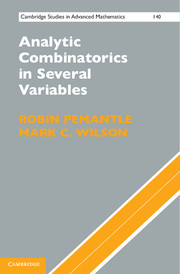Book contents
- Frontmatter
- Contents
- Preface
- PART I COMBINATORIAL ENUMERATION
- PART II MATHEMATICAL BACKGROUND
- PART III MULTIVARIATE ENUMERATION
- 8 Overview of Analytic Methods for Multivariate Generating Functions
- 9 Smooth Point Asymptotics
- 10 Multiple Point Asymptotics
- 11 Cone Point Asymptotics
- 12 Worked Examples
- 13 Extensions
- PART IV APPENDIXES
- References
- Author Index
- Subject Index
13 - Extensions
Published online by Cambridge University Press: 05 July 2013
- Frontmatter
- Contents
- Preface
- PART I COMBINATORIAL ENUMERATION
- PART II MATHEMATICAL BACKGROUND
- PART III MULTIVARIATE ENUMERATION
- 8 Overview of Analytic Methods for Multivariate Generating Functions
- 9 Smooth Point Asymptotics
- 10 Multiple Point Asymptotics
- 11 Cone Point Asymptotics
- 12 Worked Examples
- 13 Extensions
- PART IV APPENDIXES
- References
- Author Index
- Subject Index
Summary
The Diagonal Method
We recall the diagonal method from Section 2.4. When used for asymptotic coefficient extraction from a bivariate generating function F, it consists of two steps:
(i) Find a closed form or defining equation for the diagonal generating function diag F.
(ii) Apply univariate singularity analysis to diag F to compute the asymptotics.
However, this method is extremely limited in scope, working well only for the main diagonal in two variables. On the positive side, it does allow the determination of the entire diagonal generating function, not just asymptotics of the coefficients. In this section we give more details on the limitations of this method. Although they have been alluded to in Section 2.4, our experience has shown that the results in this book are better appreciated if the reader has a thorough understanding of why such results are not as easily obtainable via the older diagonal method machinery.
The first step usually works well for computing main diagonal asymptotics in two variables, as already seen in the case of Delannoy numbers in Example 2.4.12. The second can be often carried out in this case using standard univariate asymptotics. For example, if F is bivariate rational, then the diagonal is algebraic, and the transfer theorems such as Theorem 3.4.2 can be applied. The full procedure is demonstrated in the following example.
Information
- Type
- Chapter
- Information
- Analytic Combinatorics in Several Variables , pp. 300 - 316Publisher: Cambridge University PressPrint publication year: 2013
